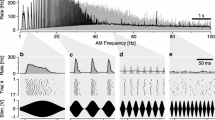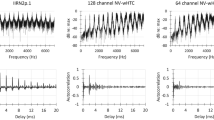Summary
-
1.
Response/intensity curves for the 50 ms periods following the onset of stimulation are given, for the anterior membrane ofPlatycleis intermedia, in Fig. 2A and for the posterior membrane ofHomorocoryphus nitidulus vicinus in Fig. 2B. These curves are frequency-dependent, varying in threshold intensity, intensity band and maximum amplitude criteria.
-
2.
Similar curves are given for the 50 ms following the termination of the stimulus, in Fig. 3A-B. Attention is drawn to the significance of these ‘off’ responses.
-
3.
The response/intensity curves are critically analysed by three different methods; for threshold; for a constant intensity level (CI); and for a constant response level (CR). The differences in the values obtained by these methods are shown in Fig. 4A-H.
-
4.
The CR (sensitivity) curves for the anterior membrane ‘on’ response ofP. intermedia are given in Fig. 5 and for the ‘off’ response in Fig. 6. The threshold curves show the typical ‘narrow-band’ spectrum, with peak sensitivity at the main carrier frequency of the song, and smaller peaks at 0.8 kHz and 30 kHz. At higher response amplitudes however, these peaks disappear, or are greatly diminished relative to other frequencies except for the low-frequency ‘off’ response.
-
5.
The CI (efficiency) curves for the anterior membrane ‘on’ response are shown for seven intensity values in Fig. 7. Increasing the intensity of stimulation emphasizes the broadband nature of the receptor and demonstrates an important high-frequency peak (70 kHz), not apparent at lower intensities. The ‘off’ responses (Fig. 8) show similar effects.
-
6.
For the posterior membrane, curves were drawn of the maximum response, and of the stimulus required to give the maximum response, against frequency. These are given for the ‘on’ response (Fig. 9) and for the ‘off’ response (Fig. 10). The posterior membrane is insensitive to the termination of the stimulus.
-
7.
No responses were obtained from the central membrane for frequencies between 200 Hz and 250 kHz.
-
8.
The response activity during each 5 ms period of the stimulus and stimulus interval is shown for the anterior and posterior membranes in Figs. 11, 12. This steady-state activity is membrane- and frequency-dependent, and clearly demonstrates the nature of the ‘off’ responses.
-
9.
The effects of varying the stimulus duration and the stimulus-interval duration, on the amplitudes of response and latencies of response, are shown in Figs. 13A and B. Consideration of these figures indicates that neither the ‘on’ nor ‘off’ responses are due to any inhibitory release or ‘rebound’ phenomena.
-
10.
The effect of environmental attenuation of sound frequencies (0.8 kHz-20 kHz) (Fig. 14) on the song spectrum (Fig. 15) suggests that distance is perceived as a variation in the intensity-response at low frequencies.
-
11.
The excess sound pressure at the spiracle, due to the diffraction of sound by the body surface, as a function of the angle of incidence (Fig. 16A-B), shows that directionality becomes possible only at frequencies above 7 kHz. The effect of this excess pressure on the song spectrum is demonstrated (Fig. 17) and suggests that directionality is a feature of higher frequencies, and can be coded as an intensity function.
-
12.
When the pronotal shield is removed, this high-frequency directionality is eliminated (Fig. 16B). Thus, the pronotum is important for the effectiveness of the sound stimulus entering the spiracle.
-
13.
The implications of these results for the mode of functioning of the ear and for acoustic behaviour are discussed. The way is now clear for the critical determination of the role of the acoustic trachea.
Similar content being viewed by others
References
Autrum, H.: Phasische und tonische Antworten vom Tympanalorgan vonTettigonia viridissima. Acustica10, 339–348 (1960)
Bailey, W. J.: The mechanics of stridulation in bush crickets (Tettigonioidea, Orthoptera). I. The tegminal generator. J. exp. Biol.52, 495–505 (1970)
Bennet-Clark, H. C.: Acoustics of insect song. Nature (Lond.)234, 255–259 (1971)
Broughton, W. B.: Glossorial index. In: Acoustic behaviour of animals, R.-G. Busnel (ed.). Amsterdam: Elsevier 1963
Broughton, W. B., Samways, M. J., Lewis, D. B.: Low-frequency sounds in the songs of some non-resonant bush crickets (with some thoughts on frequency discrimination). Ent. exp. et appl. (in press)
Busnel, R.-G., Chavasse, P.: Récherches sur les émissions sonores et ultrasonores d'Orthoptères nuisibles à l'agriculture. Études des fréquences. 2eme Congr. Rome. Nuovo Cim.7, 470–486 (1950)
Busnel, R.-G., Loher, W.: Sur l'étude du temps de la réponse au stimulus acoustique artificiel chez lesChorthippus et la rapidité de l'integration du stimulus. C.R. Soc. Biol. (Paris)148, 862–865 (1954)
Busnel, R.-G., Loher, W.: Déclenchement de phonoréponses chezChorthippus brunneus (Thbg), Acridinae. Acoustica11, 65–70 (1961)
Busnel, R.-G., Loher, W., Pasquinelli, F.: Récherches sur des signaux acoustiques synthétiques reactogènes pour divers Acrididae. C.R. Soc. Biol. (Paris)148, 1987–1991 (1954)
Dambach, M.: Vibrationssinn der Grillen. I. Schwellenmessungen an Beinen freibeweglicher Tiere. II. Antworten von Neuronen in Bauchmark. J. comp. Physiol.79, 281–324 (1972)
Dubrovin, N. N., Zhantiev, R. D.: Acoustic signals of katydids (Orthoptera, Tettigonioidea). Zool. J. USSR Acad. Sci.49, (7), 1001–1014 (1970) [In Russian.]
Grinnell, A. D.: Comparative auditory neurophysiology of neotropical bats employing different echolocation signals. Z. vergl. Physiol.68, 117–153 (1970)
Lewis, D. B.: The physiology of the tettigoniid ear. I. Implications of the anatomy of the ear to its function in sound reception. J. exp. Biol.60, 821–837 (1974a)
Lewis, D. B.: The physiology of the tettigoniid ear. II. The response characteristics of the ear to differential inputs: lesion and blocking experiments. J. exp. Biol.60, 839–851 (1974b)
Lewis, D. B.: The physiology of the tettigoniid ear. III. The response characteristics of the intact ear and some biophysical considerations. J. exp. Biol.60, 853–859 (1974c)
Michelsen, A.: The physiology of the locust ear. I. Frequency sensitivity of single cells in the isolated ear. Z. vergl. Physiol.71, 49–62 (1971a)
Michelsen, A.: The physiology of the locust ear. II. Frequency discrimination based upon resonances in the tympanum. Z. vergl. Physiol.71, 63–101 (1971b)
Michelsen, A.: The physiology of the locust ear. III. Acoustical properties of the intact ear. Z. vergl. Physiol.71, 102–128 (1971c)
Michelsen, A., Nocke, H.: Biophysical aspects of sound communication in insects. In: Advances in insect physiology. Treherne, J. E., Berridge, M. J. and Wigglesworth, V. B. (eds.). London: Academic Press 1974
Morton, E. S.: Ecological sources of selection on avian sounds. Ph.D. Thesis, Yale University (1970)
Neuweiler, G., Schuller, G., Schnitzler, H.-U.: On- and off-responses in the inferior colliculus of the greater horseshoe bat to pure tones. Z. vergl. Physiol.74, 57–63 (1971)
Nocke, H.: The tympanal trachea as an integral part of the ear inAcripesa reticulata Guerin (Orthoptera, Tettigonioidea). Z. Naturforsch.29c, 652–654 (1974)
Nocke, H.: Physical and physiological properties of the tettigoniid ear: A new hearing theory. In press (1975)
Pumphrey, R. J.: Hearing in insects. Biol. Rev.15, 107–132 (1940)
Pye, J. D.: Animal sonar in air. Ultrasonics6, 32–38 (1968)
Pye, J. D., Flinn, M.: Equipment for detecting animal ultrasound. Ultrasonics2, 23–28 (1964)
Rheinlaender, J.: Transmission of acoustic information at three neuronal levels in the auditory system ofDecticus verrucivorus (Tettigoniidae, Orthoptera). J. comp. Physiol.97, 1–54 (1975)
Roeder, K. D.: Interneurons of the thoracic cord activated by tympanic nerve fibres in noctuid moths. J. Insect Physiol.12, 1227–1244 (1966)
Wasserman, G. S.: Invertebrate colour vision and the tuned receptor paradigm. Science180, 268–275 (1973)
Zhantiev, R. D.: Frequency characteristics of tympanal organs in grasshoppers (Orthoptera, Tettigonioidea). Zool. J. USSR Acad. Sci.50, 507–514 (1970) [In Russian.]
Zhantiev, R. D., Dubrovin, N. N.: Directional sensitivity of auditory reception in the Tettigoniidae (Orthoptera). In: Adaptive Mechanisms of Acoustic Orientation. N.P. Naumov (ed.). Moscow State University (1973) [In Russian.]
Author information
Authors and Affiliations
Rights and permissions
About this article
Cite this article
Lewis, D.B., Seymour, C. & Broughton, W.B. The response characteristics of the tympanal organs of two species of bush cricket and some studies of the problem of sound transmission. J. Comp. Physiol. 104, 325–351 (1975). https://doi.org/10.1007/BF01379055
Received:
Issue Date:
DOI: https://doi.org/10.1007/BF01379055




